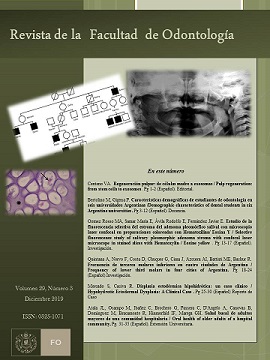Demographic characteristics of dental students in six Argentine universities
Keywords:
population dynamics, competency-based education, studentsAbstract
Introduction: A new generation of students, the Millennials generation has emerged as a consequence of structural changes in the context of globalization of University Education and social and technological development. Objectives: Identify demographic characteristics of the undergraduate student population in six dental schools of Argentina included in this study. Estimate the time of development of the career and compare the enrollment of incoming students 2018 for ten years, in the faculties of Dentistry of the national public universities of Córdoba and Buenos Aires. Methods: cross-sectional observational study was conducted in dental students of six national public and private universities in Argentina, based on directed questions. They were analyzed by means of the statistical tests: ANOVA and Chi-Square. In all cases, the level of significance was 95% (p <0.05).Results: The highest age average corresponds to the students of the University of Buenos Aires (U.B.A), while the highest percentage of female students stands out in the National University of Cuyo (UNCuyo).The average duration of years of the career is greater at the National University of Córdoba (U.N.C.). The difference in student enrollment in 2018 is heterogeneous in the universities. There were no significant fluctuations between the UNC and UBA in ten years. Conclusion: The monitoring programs allow identifying the structural and functional dynamics of the student population and their learning needs over time to adapt the programs and curriculum to the demographic and epidemiological changes in the country; customs, culture and technological advances are permanent challenges to achieve competitiveness and improve teaching work.
References
Trow, Martin. Reflexiones sobre la transición de la élite a la misa al acceso universal: formas y fases de la educación superior en las sociedades modernas desde la Segunda Guerra Mundial. Educación Universitaria en Ciencias 3 (2009): 1. 2. Brennan, John. The social role of the contemporary university: Contradictions, boundaries and change. Ten yearson: Changing education in a changing world (2004): 22-26.
3. Suasnábar, Claudio, Rovelli, Laura Ines. Ampliaciones y desigualdades en el acceso y egreso de estudiantes a la Educación Superior en la Argentina. Pro-Posições, (2016). 27(3), 81-104. 4. Conferencia Regional de Educación Superior (Cres). Declaración final de la Conferencia Regional de Educación Superior, Cartagena, Colombia. (2008).
5. Arias, S. (2017). Generación X o Generación “sándwich”. URL: http://www.psicologi camentehablando.com/lageneracion-x-o-generacion-sandwich/. Accedido: 17.10.2017. 6. López L, López B, Rivera I. Millennials,¿ irresponsables o incomprendidos? El caso de la unidad académica preparatoria Guasave diurna-uas. Revista de Investigación en Tecnologías de la Información. (2017). 5(10).
7. Llantada A. El horror de trabajar con un millennial…y con un Generación X. (2017). URL: https://www.altonivel.com.mx/horror-tra bajar-millennialgeneracion-x/. Accedido: 20.10.2018.
8. Rodríguez Burgos K; Martínez Cárdenas A; Rodríguez Serpa F. Estudio empírico sobre los valores democráticos de tolerancia y respeto en la generación milenaria. Justicia, 22, 31(2017), pp. 135-150.
9. Espinar, Sebastián Rodríguez. Los estudiantes universitarios de hoy: una visión multinivel. REDU. Revista de docencia universitaria 13.2 (2015): 91-124.
10. Burstein David. Fast Future. Australia: Beacon Press; 2013.
11. González, Melania, et al. La salud bucal en la República Argentina. Análisis del sector. Universitas Odontológica, 2019, vol. 38, no 80.
12. República de la Argentina, Ministerio de Educación, Departamento de Información Universitaria de la Secretaría de Políticas Universitarias (SPU). Anuario de Estadísticas Universitarias. Buenos Aires, Argentina: SPU; 2012 Disponible en: http://informacionpresupuestaria.siu.edu.ar/DocumentosSPU/diu/anuario_2012.pdf
13. Federación Colegio Odontólogos de la República Argentina (FACO), Instituto Nacional de Estadística y Censos (INDEC), Censo Nacional de Población, Hogares y Viviendas 2001y Censo Nacional de Población, Hogares y Viviendas 2010. Odontólogos a nivel país y porcentajes respecto a otras profesiones sanitarias. 1ª edición, Buenos Aires, Argentina: FACO, INDEC; 2013.
14. Sanz Alonso M, Antoniazzi J. Libro del Proyecto Latinoamericano de Convergencia en Educación Odontológica PLACEO. San Pablo: Editorial Artes Medicas Ltda; 2010.
15. DATOSMACROS https://datosmacro.expansion.com/demografía/población/argentina (2017) Accedido 2/5/19 16. Mercedes Collazo, Seoane Mariana, Hernández Ofelia. Perfil sociodemográfico y desempeños de los estudiantes de la carrera de Odontología (UdelaR). Odontoestomatología13.18 (2011): 46-55.
17. ONU. Agenda 2030 sobre el Desarrollo Sostenible. Disponible en: https://www.un.org/sustainabledevelopment/es/education/ último acceso: 2/5/19
Published
Issue
Section
License
Aquellos autores/as que tengan publicaciones con esta revista, aceptan los términos siguientes:
- Los autores/as conservarán sus derechos de autor y garantizarán a la revista el derecho de primera publicación de su obra, el cuál estará simultáneamente sujeto a la Licencia de reconocimiento de Creative Commons que permite a terceros:
- Compartir — copiar y redistribuir el material en cualquier medio o formato
- La licenciante no puede revocar estas libertades en tanto usted siga los términos de la licencia
- Los autores/as podrán adoptar otros acuerdos de licencia no exclusiva de distribución de la versión de la obra publicada (p. ej.: depositarla en un archivo telemático institucional o publicarla en un volumen monográfico) siempre que se indique la publicación inicial en esta revista.
- Se permite y recomienda a los autores/as difundir su obra a través de Internet (p. ej.: en archivos telemáticos institucionales o en su página web) después del su publicación en la revista, lo cual puede producir intercambios interesantes y aumentar las citas de la obra publicada. (Véase El efecto del acceso abierto).

